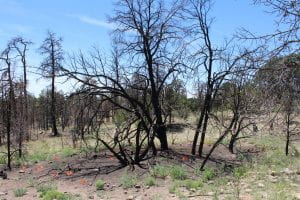What impact has fire suppression had on wildfire intensities?

Pinyon, juniper, and ponderosa pine trees killed by the 2012 San Juan prescribed burn at the archaeological site of Wabakwa in northern New Mexico. Photo by C. Roos.
Many tree-ring and charcoal studies indicate that the period of fire suppression (the last 120+ years) is unique for its paucity of fire over multi-century to multi-millennial timescales in dry forests across the Western US. Nevertheless, there are still some scholars and environmentalists who suggest that fire behaviors (for example, fire intensity, or temperature for a given area) and impacts (for example, fire severity, or the degree of above ground biomass consumption or mortality) in modern fires that follow that fire free period are within the historical range of variability for the West. Tree ring and charcoal methods are generally unable to get at fire intensities of the past to evaluate the uniqueness of fire intensities from fire suppression and fuel accumulation today.
With colleagues at Utah State University, the University of Arizona, the US Geological Survey, Southern Methodist University, and Harvard University, I have just published an innovative application of archaeological luminescence dating to assess the consequences of fire suppression and fuel accumulation on fire intensity relative to a millennium or more of frequent surface fires. By using the heat sensitive luminescence signal from archaeological ceramics exposed to historical surface fires (documented in tree-ring records) and those exposed to a 2012 prescribed burn under mild weather conditions, we were able to isolate the impact of fire suppression-generated fuel buildup on fire intensity. All ceramics burned in the 2012 fire with modern fuels had their luminescence signal reset, indicating that they were heated high enough and long enough to free electrons from crystaline traps and reset the luminescence clock. In contrast, none of the ceramics exposed to at least 14 historically documented surface fires had any evidence of resetting, indicating that fire intensities (and duration) in modern fuels had no precedent since at least before the site was established roughly 900 years ago.
Add climate change to the scenario and the combustible situation with modern fuels requires urgent action.
This paper was published in the open access journal Fire. You can find the article here or here.
Roos, Christopher I., Tammy M. Rittenour, Thomas W. Swetnam, Rachel A. Loehman, Kacy L. Hollenback, Matthew J. Liebmann, and Dana Drake Rosenstein
2020 Fire Suppression Impacts on Fuels and Fire Intensity in the Western US: Insights from Archaeological Luminescence Dating in Northern New Mexico. Fire 3:32.
Comments are Disabled